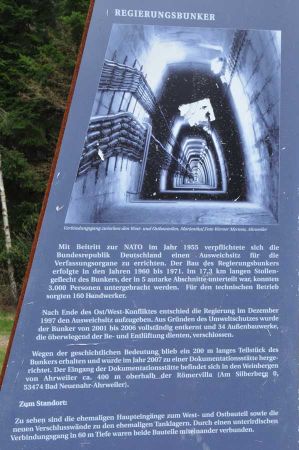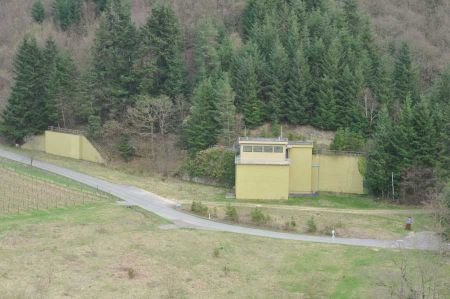The so-called government bunker in the Ahr valley near the lovable wine village of Dernau was once considered the most secret building in the recent history of the Federal Republic of Germany during the Cold War.
During its existence, the government bunker was surrounded by the aura of absolute mystery, although just the extensive construction work made it impossible to keep it secret. When construction began, rumors made the rounds in the Ahr Valley, including an underground luxury department store or even an underground brothel. There were also repeated reports of an underground connection between Bonn, then the federal capital, and the government bunker, in which even an underground train is supposed to run. This rumor, for example, read: “The tunnels go as far as Hardtberg.” What was meant, however, was not the Bonn district with the seat of the Ministry of Defense on Hardthöhe, but the Hardtberg vineyard in Dernau. There is indeed the western entrance to the government bunker.
It wasn't until much too late that it was noticed: The spy system of the GDR secret service was always and well informed about the progress of the bunker through the spy Lorenz Betzing, who was employed as a craftsman in the bunker.
A crazy idea should be implemented
 In the vernacular, “The Government Bunker” is the abbreviation for the alternative seat of the federal constitutional organs in the event of a crisis or defense in order to maintain the functionality of the government. At the time of the Cold War between the systems in East and West, another example of “burning money” of taxpayers' for the continued existence of the government in the event of an escalating conflict, perhaps a nuclear war that was even conceivable at the time. Here near Dernau, a 17.3-kilometer-long bunker system was to be built around 25 kilometers south of Bonn in the Ahr valley between Bad Neuenahr-Ahrweiler and Dernau in Rhineland-Palatinate, not far from the Marienthal state winery at the time. During the years of planning, construction and use, the government bunker was run under various aliases or cover names such as Rose Garden, department designation Dienststelle Marienthal and THW-Anlagen Marienthal.
In the vernacular, “The Government Bunker” is the abbreviation for the alternative seat of the federal constitutional organs in the event of a crisis or defense in order to maintain the functionality of the government. At the time of the Cold War between the systems in East and West, another example of “burning money” of taxpayers' for the continued existence of the government in the event of an escalating conflict, perhaps a nuclear war that was even conceivable at the time. Here near Dernau, a 17.3-kilometer-long bunker system was to be built around 25 kilometers south of Bonn in the Ahr valley between Bad Neuenahr-Ahrweiler and Dernau in Rhineland-Palatinate, not far from the Marienthal state winery at the time. During the years of planning, construction and use, the government bunker was run under various aliases or cover names such as Rose Garden, department designation Dienststelle Marienthal and THW-Anlagen Marienthal.
The bunker was built under great secrecy by the Federal Ministry of the Interior between 1960 and 1972 in two of five tunnels built at the beginning of the 20th century on the never completed Ruhr-Mosel railway track (section Liblar - Rech). The bunker was intended in particular for the civil authorities from what was then the federal capital of Bonn and was intended to serve as an alternate seat and underground command system for the German government in the event of a defense (V case) ("alternate seat of the constitutional organs").
After the end of the Cold War, the plant was shut down for cost reasons at the end of the 1990s. Just a few years later, the complete gutting of almost the entire complex began. Today just a small part of the bunker, 203 meters long, remains of the most expensive building in the Federal Republic, which has been converted into the Museum Documentation Center Government Bunker. The museum is located on a wooded mountain slope above the Roman villa in Bad Neuenahr-Ahrweiler. In 2009 the government bunker was declared a European cultural heritage by the European Commission.
As mentioned at the beginning, two rail tunnels that already existed but were still not used for their original purpose were the structural basis for all further expansion work from 1960 to 1972. Its planning dates back to 1950, including Federal Chancellor Konrad Adenauer from the beginning.
In addition to the existing 2,625 m long railway tunnels, many more transverse and longitudinal tunnels were built. Using drilling and blasting, the miners worked their way through the soft slate of the Ahr valley in the classic way, so that at the end of the construction period the entire system had a tunnel length of approx. 19 km. After deducting all tunneling work, which only served the actual construction purpose itself and which were also partially closed again at the end of the construction phase, a usable tunnel length of around 17.3 km remained to allow a so-called emergency administration of the federal government with a total of 3,000 employees to persevere Facilitate a conflict of at least 30 days.
Steadfast even in the event of a nuclear attack?
The plant itself was supposed to be safe against attack with nuclear weapons and was largely self-sufficient in terms of the supply of electrical energy, fresh air and drinking water. In contrast to other fortresses or military bunkers, however, it was not armed. The security should be taken over by federal military units in field positions, including the security and supply regiment of the BMVg. The cost of the building was estimated at around three billion DM, exact figures are not available due to the confidentiality.
The bunker, covered with up to 110 m of rock, consisted of the east and west parts separated by a valley cut, which were connected underground with a walkway at a depth of 60 m.
The main entrances could be locked with rollable MAN gates made of steel and concrete, each weighing 25 tons.
Gates and ventilation covers on the supply air structures that could be closed in fractions of a second were able to hermetically seal the bunker. A drinking water supply from two of its own deep wells, its own power generator, air filter and supplies as well as an infrastructure with kitchens, hospital, dentist, etc. enabled a 30-day stay without contact to outside. This was intended to ensure in the event of a defense (V-case) that the Federal Republic of Germany could continue to rule even in a nuclear escalating war and that the Bundeswehr could continue to be led.
As it became known in 2008, the bunker facility would have withstood a 20-kiloton bomb, comparable to the explosive force of a "Hiroshima bomb". Although as early as 1962 secret reports expected 250 times more powerful weapons and it was clear that the facility would collapse in an emergency in the event of a nuclear strike, the construction project was continued for political reasons.
The end of the government bunker after the fall of the wall
In the last stage of construction, which should have been expanded due to the increased space requirement, the bunker could accommodate around 3,000 people who, with the exception of the Federal Chancellor and Federal President, were accommodated in multi-bed rooms, with the bedrooms being sparsely furnished throughout. When it was completed in 1971, the bunker had grown to 17.3 km and comprised 936 bedrooms and 897 offices. There were around 3,300 steel doors in this complex to separate these rooms and even an underground hairdressing salon had been thought of.
In the event of defense, the bunker should accommodate the Federal President, the Federal Chancellor, the Joint Committee, the President of the Federal Constitutional Court, various ministers and civil and military personnel. The briefings took place in a large conference room with map walls right next to the rooms of the Federal Chancellery.
In the government bunker, exercises were held every two years as part of the NATO exercise WINTEX, during which the staff also worked in hermetic operation for up to 30 days. For example, the legislative process was simulated with an emergency parliament of 22 members, and an existing Federal Chancellor (Bundeskanzler-Üb) and a Federal President were not missing.
Around 180 people were constantly on duty in three shifts for maintenance, repair and operation. For reasons of secrecy, employees with civil servant and salaried status were only recruited in the region and bound to strict secrecy.
Please read as well:
Albania's bunker history - the Bunk'Art Museum Tirana
Roupel Pass and Museum - discuss history openly!
Agkistro - More facts about the fortress of Roupel

